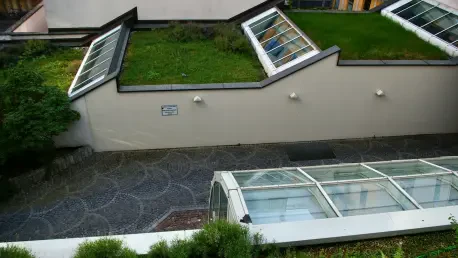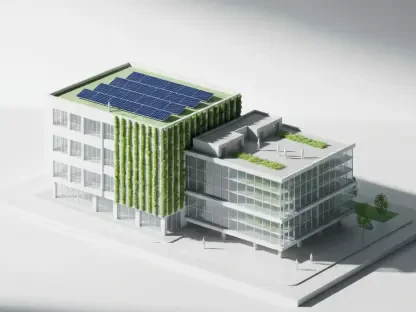The Malone Family Tower, a recent addition to MaineHealth’s medical center campus in Portland, not only enhances patient care but also makes significant strides in environmental sustainability. Opened in June, the tower aligns with MaineHealth’s commitment to creating a healthier and more sustainable future by adhering to the rigorous standards of the LEED Silver Certification. This globally recognized green building rating system acknowledges buildings that exhibit exceptional energy efficiency, resource conservation, and overall environmental responsibility. The Malone Family Tower exemplifies these principles through its innovative design and sustainable practices, setting a new standard for healthcare facilities.
Key Sustainable Features of Malone Family Tower
Among the tower’s most notable features are its efficient water and HVAC systems, which significantly reduce energy consumption. By utilizing over 18,000 tons of recycled concrete and 300 tons of metal, the construction process itself minimized waste and promoted the reuse of materials. These efforts not only conserve valuable resources but also reduce the building’s overall environmental footprint. Additionally, the incorporation of efficient lighting and heating systems further contributes to energy savings, making the tower a model of sustainable development in the healthcare industry.
One of the most visually striking and functionally beneficial elements of the Malone Family Tower is its expansive Green Roof. This accessible outdoor space, primarily composed of hardy sedum plants, provides numerous health and environmental benefits. The Green Roof serves as a welcoming area for patients, visitors, and staff to socialize and engage in physical activities. Its design aims to create a serene environment, promoting mental well-being and a sense of tranquility amidst the hustle and bustle of a medical facility. This combination of aesthetic appeal and practical functionality underscores the tower’s commitment to sustainability and patient care.
Health Benefits of the Green Roof
The therapeutic effects of the Green Roof extend beyond its role as an inviting outdoor space. Research has shown that exposure to natural environments can significantly improve mental health, reducing symptoms of anxiety, depression, and even chronic pain. The presence of greenery and the opportunity for fresh air can enhance overall patient satisfaction, fostering a more positive healing environment. This is particularly important for patients undergoing long-term treatments, as the Green Roof offers a much-needed respite from the clinical setting, promoting relaxation and recovery.
Furthermore, the Green Roof at Malone Family Tower plays a crucial role in rainwater management. Sedum plants are highly effective in absorbing a significant portion of annual rainfall, ranging from 75% to 90%. This natural absorption process reduces runoff, thereby decreasing the strain on urban drainage systems and improving water quality. By mitigating runoff, the Green Roof helps prevent potential flooding and water pollution, contributing to a healthier local ecosystem. This sustainable approach to water management exemplifies the forward-thinking design principles that underpin the entire Malone Family Tower project.
Environmental Impact and Urban Benefits
In addition to its water management capabilities, the Green Roof also addresses the challenge of urban heat islands, which are areas that experience higher temperatures due to human activities and dense infrastructure. The heat-absorbing properties of the sedum plants help lower temperatures in the surrounding urban area, reducing the risk of heat-related illnesses. This cooling effect also translates into decreased energy costs, as buildings require less air conditioning during hot weather. Furthermore, by lowering overall air pollution levels, the Green Roof contributes to cleaner, healthier air for the community.
The sustainability practices implemented at the Malone Family Tower offer valuable insights and inspiration for homeowners looking to adopt similar green strategies. By integrating elements such as green roofs on homes, sheds, or garages, individuals can contribute to environmental conservation while enhancing their own living spaces. Greener patios or decks, equipped with plant boxes, can serve as micro-oases, promoting biodiversity and personal well-being. Installing rain barrels for water recycling and replacing parts of traditional lawns with low-water ground covers like sedum are practical steps that can make a substantial difference in sustainability efforts.
A Vision for a Sustainable Future
The Malone Family Tower, a new development at MaineHealth’s medical center campus in Portland, not only boosts patient care but also marks a significant move towards environmental sustainability. Opened in June, the tower is aligned with MaineHealth’s dedication to fostering a healthier and more sustainable future. It meets the demanding standards required for the LEED Silver Certification, a globally recognized green building rating system. This certification honors buildings demonstrating outstanding energy efficiency, resource conservation, and overall environmental responsibility. By achieving this certification, the Malone Family Tower showcases its commitment to these values through its advanced design and sustainable practices. This innovation sets a new benchmark for healthcare facilities, aiming to deliver quality care while minimizing environmental impact. The tower stands as a testament to the integrated approach of combining superior healthcare services with an unwavering commitment to sustainability, reflecting MaineHealth’s vision of a better, healthier future for all.









